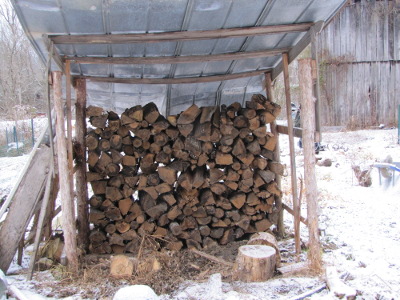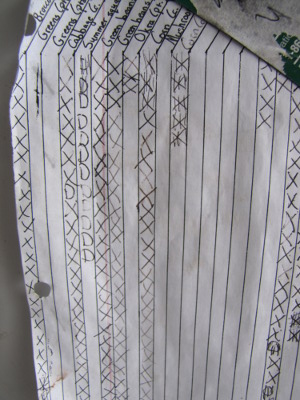
Midwinter stores
 Despite
what the calendar says, I consider this the halfway point of winter.
Despite
what the calendar says, I consider this the halfway point of winter.
From a heating
perspective, January is the coldest month. That means we should
be midway through our wood supply, but we've actually used more than we
should have. It's been a warm, but sedentary, winter, and I've
burnt excess wood so I wouldn't irritate my carpal tunnel while
pounding away on the keyboard. We have plenty more out at the
parking area if the driveway ever cooperates, but for now we've only
got about 40% of the farmside wood left. Time to be a little more
sparing.
 From
a food storage perspective, I'd say we're only a third of the way
through winter. Even though our Persephone
Days
will soon be over and the winter greens will start growing again, we
won't pick anything non-leafy until oyster mushrooms pop up in March,
asparagus in April, and then finally strawberries, broccoli, and more
in May. Here, we've done a much better job than with our wood
stores, in large part due to the seemingly endless supplies of lettuce
and greens from the quick hoops. Of the 28.75 gallons of winter
vegetables we stored away, we've consumed a mere 4.5 gallons.
We'd better pick up the pace!
From
a food storage perspective, I'd say we're only a third of the way
through winter. Even though our Persephone
Days
will soon be over and the winter greens will start growing again, we
won't pick anything non-leafy until oyster mushrooms pop up in March,
asparagus in April, and then finally strawberries, broccoli, and more
in May. Here, we've done a much better job than with our wood
stores, in large part due to the seemingly endless supplies of lettuce
and greens from the quick hoops. Of the 28.75 gallons of winter
vegetables we stored away, we've consumed a mere 4.5 gallons.
We'd better pick up the pace!
Want more in-depth information? Browse through our books.
Or explore more posts by date or by subject.
About us: Anna Hess and Mark Hamilton spent over a decade living self-sufficiently in the mountains of Virginia before moving north to start over from scratch in the foothills of Ohio. They've experimented with permaculture, no-till gardening, trailersteading, home-based microbusinesses and much more, writing about their adventures in both blogs and books.
Want to be notified when new comments are posted on this page? Click on the RSS button after you add a comment to subscribe to the comment feed, or simply check the box beside "email replies to me" while writing your comment.

Anna, Do you anticipate changing your summer production and freezing plans now that you have more experience with quick hoops - and now know you can have more fresh greens overwintere? Do you think you might try some winter roots under quick hoops next year to complement the greens? Reading Eliot Coleman, I would think that turnips, radish, beets, and carrots would probably be reasonably easy in your winter climate. Have you thought of trying to get summer squash, broccoli, and cauliflower to start in April/May using quick hoops to get a faster start this spring, as the Persephone days end? I bought agribon 15 for this spring here in Northern VA, but mostly hope it will help with early insect pressure on brassicas and lettuces, that I have a difficult time getting going, rather than give additional heat to get summer crops going earlier. I haven't yet decided if I will put it as a floating row cover or bend conduit for quick hoop supports.
Excellent question! We actually tweaked our winter storage plans last year a bit in hopes the quick hoops would pay off --- you might notice that I had two columns for greens on my chart and didn't freeze any. I'm very glad we moved in that direction, because, honestly, when I have fresh lettuce and greens, the only other vegetables I really want out of the freezer are soup and sun-dried tomatoes. We'll continue to tweak our campaign once we see how much leftover we have in the spring.
I don't really want to store winter roots under quick hoops, though. In our freeze-thaw climate, it's tough to get roots to survive the winter in the ground, and our fridge (the smallest we could get short of a dorm fridge, but still way too large for us) can keep carrots all winter easily. I didn't mention in this post, but we have lots of fresh carrots, sweet potatoes, white potatoes, garlic, and butternut squash to complement the winter stores --- yet another reason we eat so little out of the freezer.
We used our quick hoops to start our cabbage and broccoli last spring, and plan to repeat it this year. You don't get crops quite as early as you'd get starting the seedlings inside, but it's so much easier that it's totally worth it for us. (I might start a flat inside to complement the quick hoops this year and give us a bit earlier broccoli.)